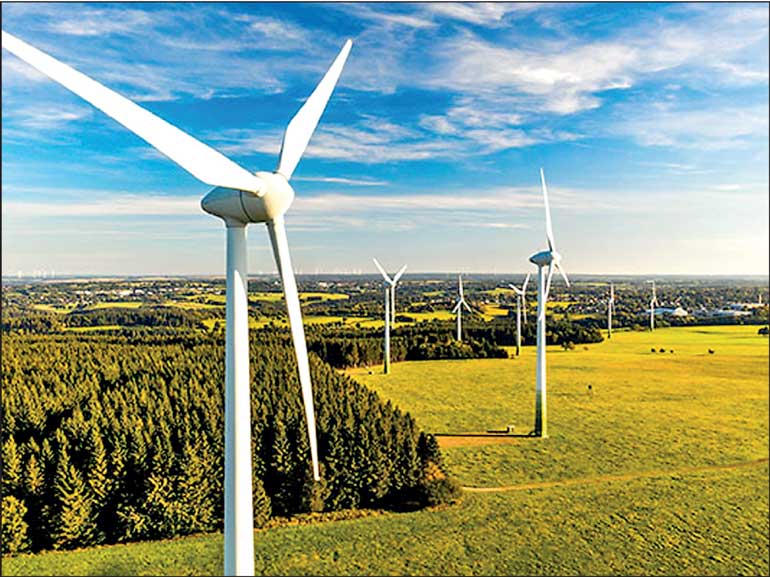Saturday Jan 10, 2026
Saturday Jan 10, 2026
Tuesday, 14 May 2024 00:10 - - {{hitsCtrl.values.hits}}

Samarajiva bemoans the fact that wind projects in Sri Lanka must pass an environmental impact assessment whereas those in India need not. And that is somehow a good thing?
 In his article, “Electricity sector: Without investment we will be in the dark again” (Daily FT, 7 April, 2024), Professor Rohan Samarajiva, evidently the latest apologist for India’s Adani Group, writes, “An eminent public intellectual, Rohan Pethiyagoda, bemoans the fact that a unit of electricity produced by the wind power facility proposed by Adani will cost more than wind-produced electricity in the US and in India.” He goes on, in the manner of a gifted prestidigitator, to cite a litany of excuses that argue for waiving the rules to help Adani cream of more than $ 700 million in excess profits from Sri Lankan electricity consumers. Much of what he writes consists purely of smoke and mirrors. But let’s cut to the bone.
In his article, “Electricity sector: Without investment we will be in the dark again” (Daily FT, 7 April, 2024), Professor Rohan Samarajiva, evidently the latest apologist for India’s Adani Group, writes, “An eminent public intellectual, Rohan Pethiyagoda, bemoans the fact that a unit of electricity produced by the wind power facility proposed by Adani will cost more than wind-produced electricity in the US and in India.” He goes on, in the manner of a gifted prestidigitator, to cite a litany of excuses that argue for waiving the rules to help Adani cream of more than $ 700 million in excess profits from Sri Lankan electricity consumers. Much of what he writes consists purely of smoke and mirrors. But let’s cut to the bone.
Samarajiva bemoans the fact that wind projects in Sri Lanka must pass an environmental impact assessment whereas those in India need not. And that is somehow a good thing? How come I haven’t seen him out and about arguing for the repeal of Article 27(11) of the Constitution (“The State shall protect, preserve and improve the environment for the benefit of the community”)? Or for repealing the National Environmental Act (NEA)? Why is he coming out to argue against environmental safeguards only when the Adani’s interests are at stake?
Let me be clear about my principal objections to the Government’s award of the 250-megawatt wind power project to Adani last week. The price agreed to by the Government is USD cents 8.26 per unit. This is 250% higher than the price Adani charges from its wind projects in India. Correctly noting that insolvent Sri Lanka is a high-risk market, Samarajiva argues, “The higher the risk, the higher the expected return”. I agree. What I do question is how that risk premium is estimated. In my view, this can be done only through open competitive bidding. That, after all, is transparent. However, for Adani’s Mannar wind project, there was no such bidding process: instead, the government accepted an unsolicited offer from Adani, claiming it to be a government-to-government transaction, which it manifestly is not (unless it claims, perhaps accurately, that Adani and the Government of India are synonymous).
 Then there’s the matter of price. The Environmental Impact Assessment (EIA, page 233, para 5) submitted by the Sustainable Energy Authority, an agency under the Minister of Power and Energy, states “Consequently, the main environmental benefit to the economy is the 25-year commitment to zero emissions at a price of USD cents 4.6 per kWh.” That was in January 2024, since when the risks have not changed. The government, however, has now decided to pay Adani USD cents 8.26 per unit. Into whose pocket is the extra USD cents 3.66 going? For the 1,000 gigawatt-hours Adani plans to generate from Mannar, that amounts to $ 36.6 million per year for 20 years: a staggering Rs. 220 billion, which is about as much as the national education budget. I wonder how the Good Professor is going to wriggle out of that one.
Then there’s the matter of price. The Environmental Impact Assessment (EIA, page 233, para 5) submitted by the Sustainable Energy Authority, an agency under the Minister of Power and Energy, states “Consequently, the main environmental benefit to the economy is the 25-year commitment to zero emissions at a price of USD cents 4.6 per kWh.” That was in January 2024, since when the risks have not changed. The government, however, has now decided to pay Adani USD cents 8.26 per unit. Into whose pocket is the extra USD cents 3.66 going? For the 1,000 gigawatt-hours Adani plans to generate from Mannar, that amounts to $ 36.6 million per year for 20 years: a staggering Rs. 220 billion, which is about as much as the national education budget. I wonder how the Good Professor is going to wriggle out of that one.
There’s a plethora of defects in the EIA, but I will highlight just two. First, Section 33(b) of the NEA stipulates that the EIA must include “a description of alternative to the activity which might be less harmful to the environment together with the reasons why such alternatives were rejected”. The EIA contains no such discussion of alternatives; neither does it state why they were rejected. This alone invalidates the EIA in its entirety. It violates the National Environmental Act and so must be rejected. The NEA is unambiguous in this regard: no ifs, no buts.
Additionally, the EIA (and indeed, its terms of reference) are defective in that there is no consideration, or even mention, of the process or costs of decommissioning these structures when they reach end of life. Who will be liable for that? Certainly not Adani, and so the poor people of Mannar will have to carry the can for that, too.
I fully understand Prof. Samarajiva’s anxiousness to lead the cheer squad for Adani, but he would do well to balance his enthusiasm with the fact that this project will violate numerous laws, regulations, procedures and procurement guidelines. Although Samarajiva is apparently oblivious to it, Sri Lanka is a notoriously corrupt country. It has been slipping steadily down the Corruption Barometer of Transparency International ever since 2020 (www.transparency.org/en/countries/sri-lanka). What’s more, Bloomberg News reported as recently as 15 March that the “US [is] Probing Indian Billionaire Gautam Adani and His Group Over Potential Bribery the Adani Corporation” (www.bloomberg.com/news/articles/2024-03-15/us-prosecutors-widen-investigation-into-adani-group-focus-on-potential-bribery?embedded-checkout=true).
But the proof of the pudding is in the eating. Just yesterday, the CEB closed bids for 50 megawatts of wind power. The prices quoted in those two-envelope bids will be read out only about a month from now, but I will eat my hat if at least some of those bids don’t fall below the USD cents 8.26 the Government is paying Adani. And remember, a 50 MW project is much smaller than Adani’s 250 MW. It doesn’t enjoy the economies of scale and all the breaks that Adani is getting from the government. Question is, will Samarajiva eat his hat if I am right? Come on, professor, put your money where your mouth is. Then again, it wouldn’t surprise me if those second envelopes are never opened…
Our country became insolvent, a global pariah, because we allowed politicians to break the rules. Just two years ago, our youth evicted a disastrous president and demanded a system change. The failed ideology of that regime was crafted by eminent intellectuals such as Professor W.D. Lakshman, Professor Channa Jayasumana, Dr. Anuruddha Padeniya and Professor Priyantha Yapa. By espousing and turning apologist-in-chief for a multibillion-dollar deal that is notoriously untransparent if not downright illegal, Professor Rohan Samarajiva risks a similar fate.
Sri Lanka needs at least 2 gigawatts of wind power urgently. I am all for it. But like the wind, it must be transparent.